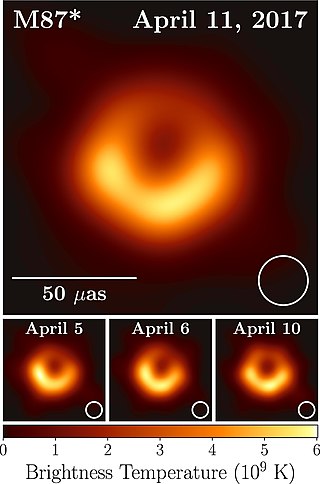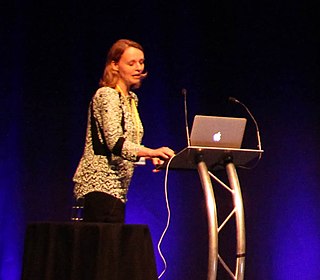
The cosmic microwave background is microwave radiation that fills all space in the observable universe. It is a remnant that provides an important source of data on the primordial universe. With a standard optical telescope, the background space between stars and galaxies is almost completely dark. However, a sufficiently sensitive radio telescope detects a faint background glow that is almost uniform and is not associated with any star, galaxy, or other object. This glow is strongest in the microwave region of the radio spectrum. The accidental discovery of the CMB in 1965 by American radio astronomers Arno Penzias and Robert Wilson was the culmination of work initiated in the 1940s.

The Wilkinson Microwave Anisotropy Probe (WMAP), originally known as the Microwave Anisotropy Probe, was a NASA spacecraft operating from 2001 to 2010 which measured temperature differences across the sky in the cosmic microwave background (CMB) – the radiant heat remaining from the Big Bang. Headed by Professor Charles L. Bennett of Johns Hopkins University, the mission was developed in a joint partnership between the NASA Goddard Space Flight Center and Princeton University. The WMAP spacecraft was launched on 30 June 2001 from Florida. The WMAP mission succeeded the COBE space mission and was the second medium-class (MIDEX) spacecraft in the NASA Explorer program. In 2003, MAP was renamed WMAP in honor of cosmologist David Todd Wilkinson (1935–2002), who had been a member of the mission's science team. After nine years of operations, WMAP was switched off in 2010, following the launch of the more advanced Planck spacecraft by European Space Agency (ESA) in 2009.
Observational cosmology is the study of the structure, the evolution and the origin of the universe through observation, using instruments such as telescopes and cosmic ray detectors.

David Todd Wilkinson was an American cosmologist, specializing in the study of the cosmic microwave background radiation (CMB).

Charles L. Bennett is an American observational astrophysicist. He is a Bloomberg Distinguished Professor, the Alumni Centennial Professor of Physics and Astronomy and a Gilman Scholar at Johns Hopkins University. He is the Principal Investigator of NASA's highly successful Wilkinson Microwave Anisotropy Probe (WMAP).
Edward L. (Ned) Wright is an American astrophysicist and cosmologist. He has worked on space missions including the Cosmic Background Explorer (COBE), Wide-field Infrared Survey Explorer (WISE), and Wilkinson Microwave Anisotropy Probe (WMAP) projects.
Scott Duncan Tremaine is a Canadian-born astrophysicist. He is a fellow of the Royal Society of London, the Royal Society of Canada and the National Academy of Sciences. Tremaine is widely regarded as one of the world's leading astrophysicists for his contributions to the theory of Solar System and galactic dynamics. Tremaine is the namesake of asteroid 3806 Tremaine. He is credited with coining the name "Kuiper belt".

Lyman Alexander Page, Jr. is the James S. McDonnell Distinguished University Professor of Physics at Princeton University. He is an expert in observational cosmology and one of the original co-investigators for the Wilkinson Microwave Anisotropy Probe (WMAP) project that made precise observations of the electromagnetic radiation from the Big Bang, known as cosmic background radiation.
The Gruber Prize in Cosmology, established in 2000, is one of three prestigious international awards worth US$500,000 awarded by the Gruber Foundation, a non-profit organization based at Yale University in New Haven, Connecticut.

Feryal Özel is a Turkish-American astrophysicist born in Istanbul, Turkey, specializing in the physics of compact objects and high energy astrophysical phenomena. As of 2022, Özel is the Department Chair and a professor at the Georgia Institute of Technology School of Physics in Atlanta. She was previously a professor at the University of Arizona in Tucson, in the Astronomy Department and Steward Observatory.
Matias Zaldarriaga is a theoretical physicist best known for his work on cosmology. He has made significant contributions toward understanding both astrophysical phenomena and fundamental physics, most notably through his research on modeling the early universe and analyzing statistical properties of cosmic microwave background data. Zaldarriaga grew up in Buenos Aires, Argentina and received his undergraduate degree from the University of Buenos Aires in 1994. He received his PhD in 1998 from the Massachusetts Institute of Technology, followed by a postdoctoral fellowship at the Institute for Advanced Study in Princeton, NJ. Zaldarriaga was a faculty member at New York University and Harvard University, where he received a MacArthur Fellowship in 2006. He is currently a professor at the Institute for Advanced Study, where he has been a faculty member since 2009.

Licia Verde is an Italian cosmologist and theoretical physicist and currently ICREA Professor of Physics and Astronomy at the University of Barcelona. Her research interests include large-scale structure, dark matter, dark energy, inflation and the cosmic microwave background.
Michele Limon is an Italian research scientist at the University of Pennsylvania. Limon studied physics at the Università degli Studi di Milano in Milan, Italy and completed his post-doctoral work at the University of California, Berkeley. He has been conducting research for more than 30 years and has experience in the design of ground, balloon and space-based instrumentation. His academic specialties include Astrophysics, Cosmology, Instrumentation Development, and Cryogenics.
Rachel Bean is a cosmologist and theoretical astrophysicist. She is a professor of astronomy and the interim dean of the Cornell University College of Arts and Sciences.
Olivier Doré is a cosmologist, who is currently working as research scientist in Jet Propulsion Laboratory and visiting associate faculty at the California Institute of Technology.

Hiranya Vajramani Peiris is a British astrophysicist at University College London and Stockholm University, best known for her work on the cosmic microwave background radiation. She was one of 27 scientists who received the Breakthrough Prize in Fundamental Physics in 2018 for their "detailed maps of the early universe."

Joanna Dunkley is a British astrophysicist and Professor of Physics at Princeton University. She works on the origin of the Universe and the Cosmic microwave background (CMB) using the Atacama Cosmology Telescope, the Simons Observatory and the Large Synoptic Survey Telescope (LSST).
Gary F. Hinshaw is a cosmologist and physics professor at the University of British Columbia. Hinshaw worked on the Wilkinson Microwave Anisotropy Probe (WMAP) whose observations of Cosmic Microwave Background (CMB) have provided significant insights into cosmology. He holds both US and Canadian citizenship.
Norman C. Jarosik is a US astrophysicist. He has worked on the Wilkinson Microwave Anisotropy Probe (WMAP) whose observations of Cosmic Microwave Background Radiation (CMBR) have provided significant insights into cosmology.
Shirley Ho is an American astrophysicist and machine learning expert, currently at the Center for Computational Astrophysics at Flatiron Institute in NYC and at the New York University and the Carnegie Mellon University. Ho also has visiting appointment at Princeton University.









